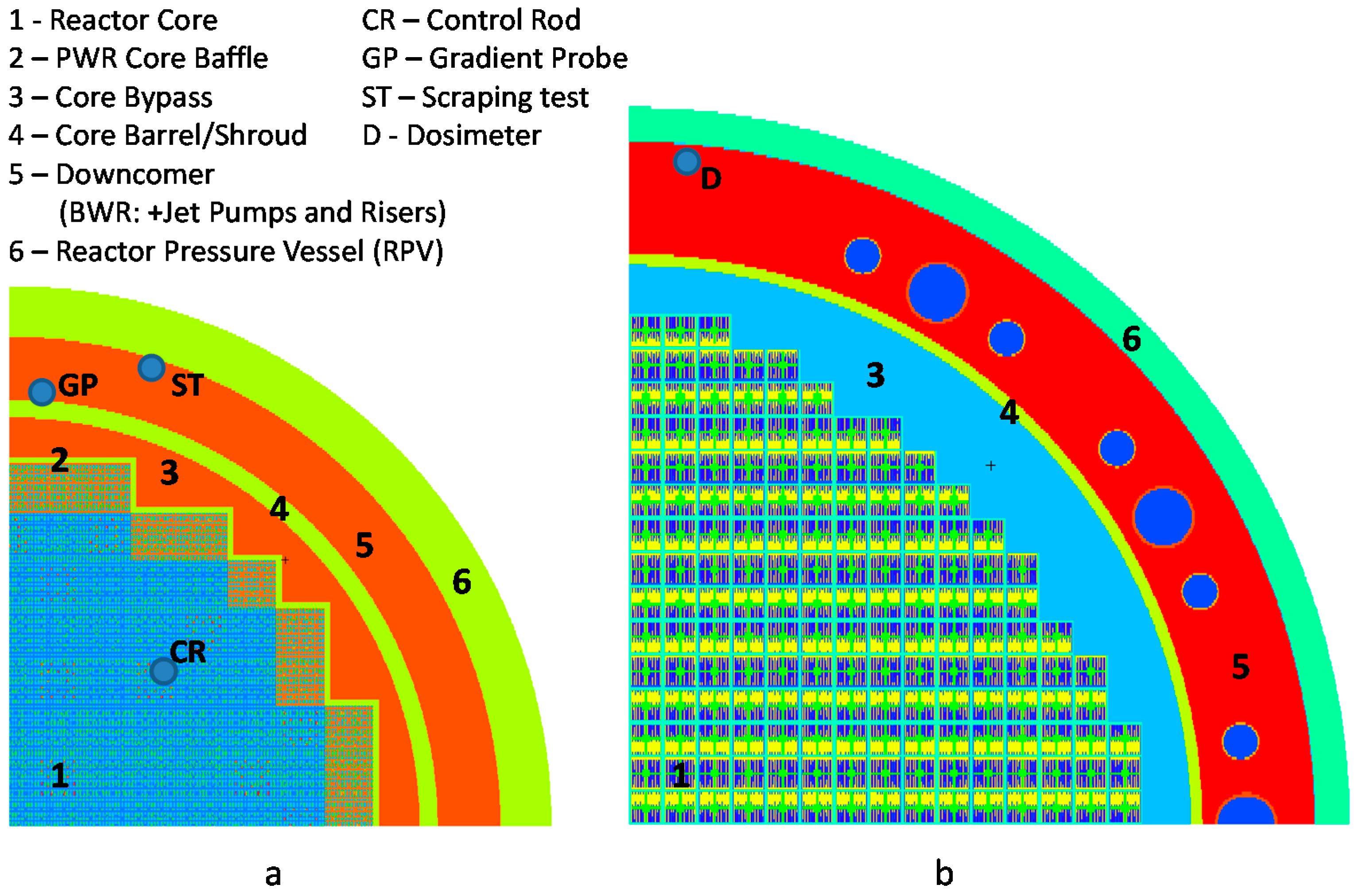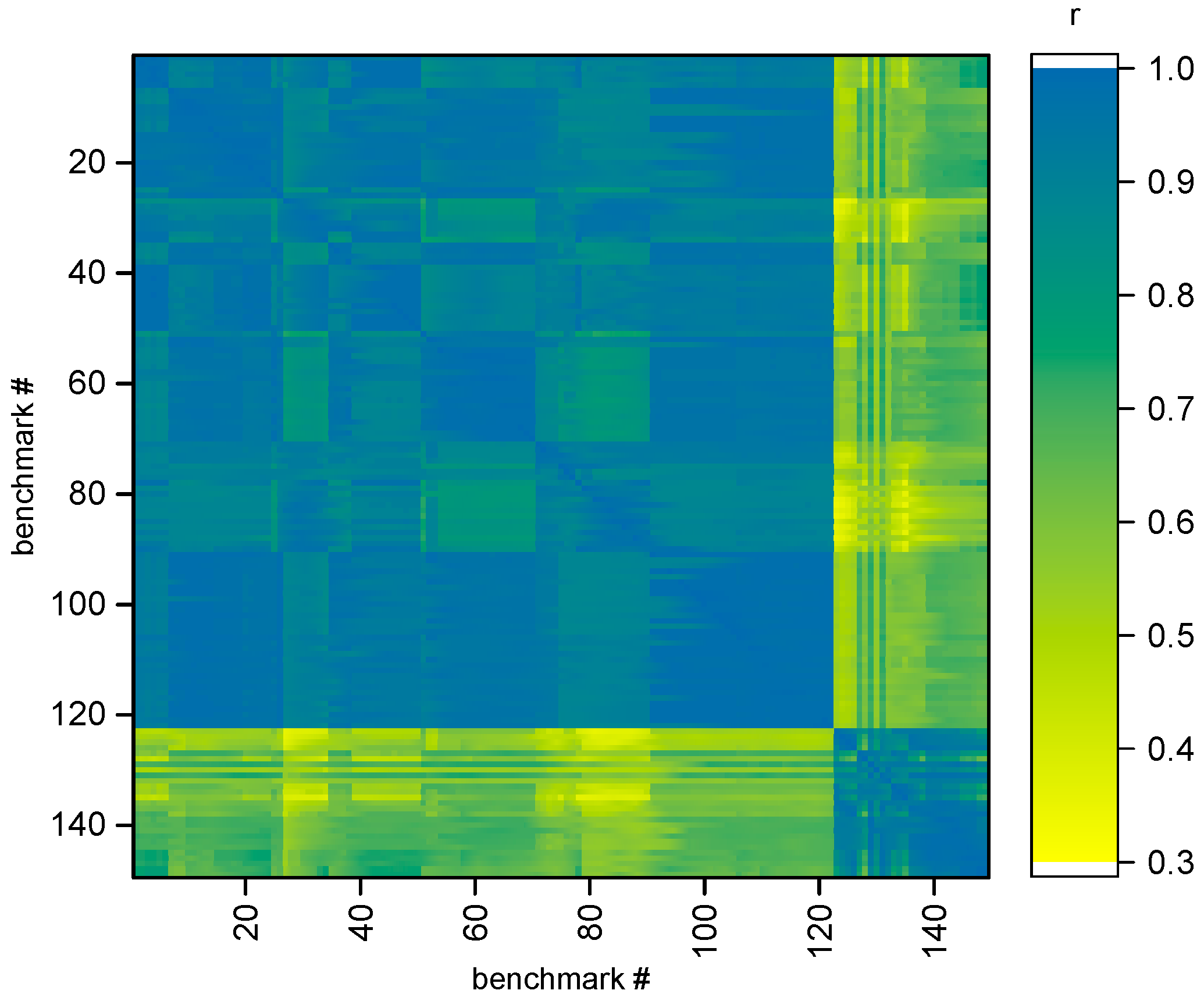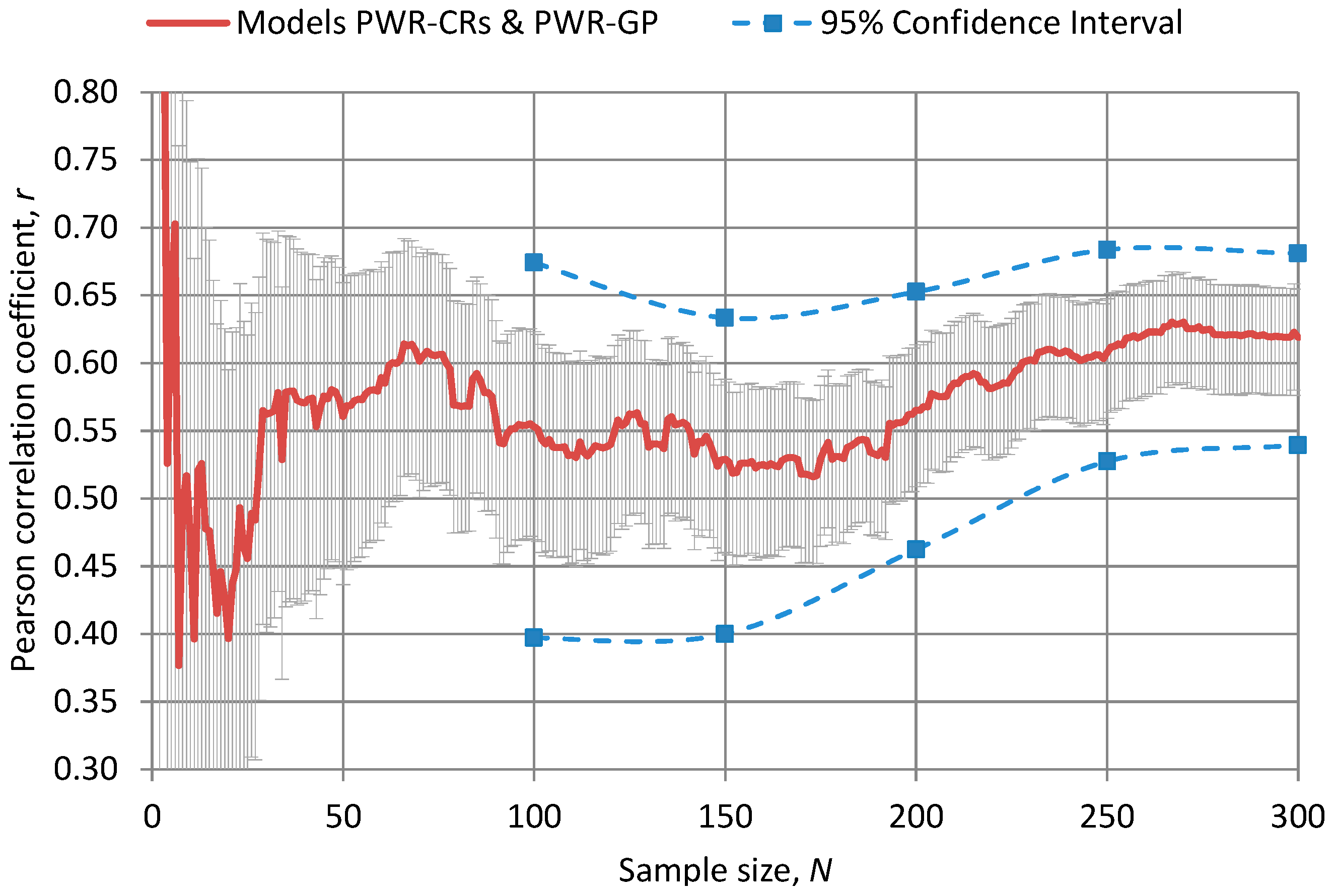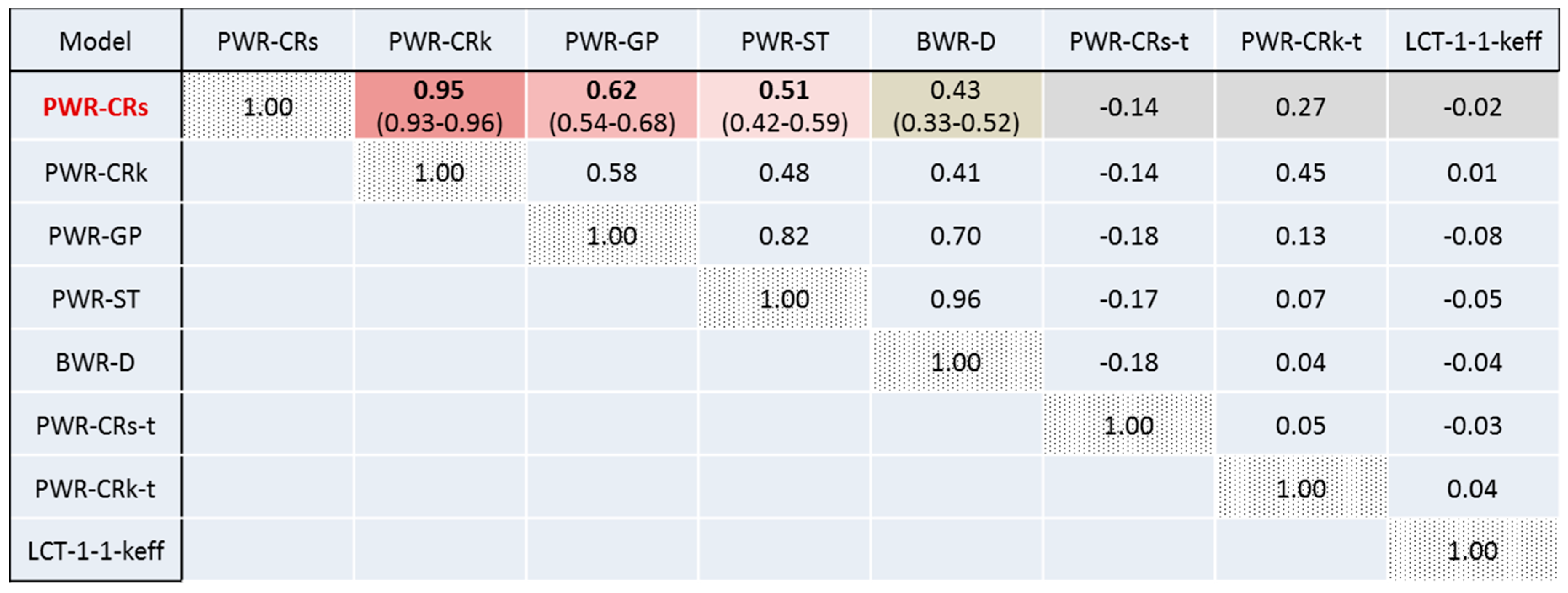Exploring Stochastic Sampling in Nuclear Data Uncertainties Assessment for Reactor Physics Applications and Validation Studies
Abstract
:1. Introduction
2. Subject of the Given Study
3. Description of the Calculation Models and the Calculation Methodologies
4. Obtained Uncertainties Results
4.1. General Description and Assessment
4.2. Observations and Trends Analysis
5. Further Profits from the Stochastic Sampling Results
5.1. Evaluation and Preliminary Assessment of Correlations
5.2. Results Examination and Verification
6. Discussion
7. Materials and Methods
8. Conclusions
Acknowledgments
Author Contributions
Conflicts of Interest
References
- Calculational and Dosimetry Methods for Determining Pressure Vessel Neutron Fluence; Regulatory Guide 1.190; U.S. Nuclear Regulatory Commission (US NRC): Washington, DC, USA, 2001.
- Validation of Neutron Transport Methods for Nuclear Criticality Safety Calculations; ANSI/ANS-8.24-2007; American Nuclear Society (ANS): La Grange Park, IL, USA, 2007.
- Reprot NEA/NSC/DOC(95)03. In International Handbook of Evaluated Criticality Safety Benchmark Experiments; The Organization for Economic Co-operation and Development/Nuclear Energy Agency (OECD/NEA): Paris, France, 2012.
- Broadhead, B.L.; Rearden, B.T.; Hopper, C.M.; Wagschal, J.J.; Parks, C.V. Sensitivity-and uncertainty-based criticality safety validation techniques. Nucl. Sci. Eng. 2004, 146, 340–366. [Google Scholar] [CrossRef]
- Ivanova, T.; McKnight, R.; Mennerdahl, D.; Neuber, J.C.; Rearden, B.; Santamarina, A.; Vasiliev, A. Overview of Approaches Used to Determine Calculational Bias in Criticality Safety Assessment; NEA/NSC/WPNCS/DOC(2013)7; Organization for Economic Co-operation and Development/Nuclear Energy Agency (OECD/NEA): Boulogne-Billancourt, France, 2013. [Google Scholar]
- Vasiliev, A.; Kolbe, E.; Zimmermann, M.A. Towards the development of upper subcriticality limits on the basis of benchmark criticality calculations. Ann. Nucl. Energy 2008, 35, 1831–1841. [Google Scholar] [CrossRef]
- Rearden, B.T.; Mueller, D.E. Uncertainty quantification techniques of SCALE/TSUNAMI. Trans. Am. Nucl. Soc. 2011, 104, 371. [Google Scholar]
- Rearden, B.T.; Williams, M.L.; Jessee, M.A.; Mueller, D.E.; Wiarda, D.A. Sensitivity and uncertainty analysis capabilities and data in SCALE. Nucl. Technol. 2011, 17, 236–288. [Google Scholar] [CrossRef]
- Rearden, B.T. Perturbation Theory Eigenvalue Sensitivity Analysis with Monte Carlo Techniques. Nucl. Sci. Eng. 2004, 146, 367–382. [Google Scholar] [CrossRef]
- Perfetti, C.M.; Rearden, B.T.; Martin, W.R. SCALE continuous-energy eigenvalue sensitivity coefficient calculations. Nucl. Sci. Eng. 2016, 182, 332–353. [Google Scholar] [CrossRef]
- Kiedrowski, B.C.; Brown, F.B.; Wilson, P.P.H. Adjoint-Weighted Tallies for k-Eigenvalue Calculations with Continuous-Energy Monte Carlo. Nucl. Sci. Eng. 2011, 168, 226–241. [Google Scholar] [CrossRef]
- Pelowitz, D.B. (Ed.) MCNPX User’s Manual; LA-CP-11-00438, Version 2; Los Alamos National Laboratory (LANL): Los Alamos, NM, USA, 2011.
- A General Monte Carlo N-Particle (MCNP) Transport Code. Available online: https://laws.lanl.gov/vhosts/mcnp.lanl.gov/mcnp_how_to_get_to_mcnp.shtml (accessed on 6 November 2016).
- Organization for Economic Co-operation and Development/Nuclear Energy Agency (OECD) Nuclear Energy Agency (NEA)/Nuclear Science Committee (NSC)/Working Party on International Nuclear Data Evaluation Co-operation (WPEC) Subgroup 33. Methods and Issues for the Combined Use of Integral Experiments and Covariance Data. Available online: https://www.oecd-nea.org/science/wpec/sg33/ (accessed on 21 September 2016).
- Perfetti, C.M.; Rearden, B.T. Development of a generalized perturbation theory method for uncertainty and sensitivity analysis using continuous-energy Monte Carlo methods. Nucl. Sci. Eng. 2016, 182, 354–368. [Google Scholar] [CrossRef]
- Ionescu-Bujor, M.; Cacuci, D.G. Comparative review of sensitivity and uncertainty analysis of large-scale systems—I: Deterministic methods. Nucl. Sci. Eng. 2004, 147, 189–203. [Google Scholar]
- Cacuci, D.G. Second-order adjoint sensitivity analysis methodology (2nd-ASAM) for computing exactly and efficiently first-and second-order sensitivities in large-scale linear systems: I. Computational methodology. J. Comput. Phys. 2015, 284, 687–699. [Google Scholar] [CrossRef]
- Gandini, A. Implicit and explicit higher order perturbation methods for nuclear reactor analysis. Nucl. Sci. Eng. 1978, 67, 347–355. [Google Scholar] [CrossRef]
- Wang, C.; Abdel-Khalik, H.S. Exact-to-precision generalized perturbation theory for neutron transport calculation. Nucl. Eng. Des. 2015, 651–660. [Google Scholar] [CrossRef]
- Cacuci, D.G. The second-order adjoint sensitivity analysis methodology for nonlinear systems—I: Theory. Nucl. Sci. Eng. 2016, 184, 16–30. [Google Scholar] [CrossRef]
- Cacuci, D.G.; Ionescu-Bujor, M. Sensitivity and uncertainty analysis, data assimilation, and predictive best-estimate model calibration. In Handbook of Nuclear Engineering Volume I Nuclear Engineering Fundamentals; Cacuci, D.G., Ed.; Springer: Berlin, Germany, 2010. [Google Scholar]
- Salvatores, M.; Palmiotti, G.; Aliberti, G.; Archier, P.; De Saint Jean, C.; Dupont, E.; Herman, M.; Ishikawa, M.; Ivanova, T.; Ivanov, E.; et al. Methods and issues for the combined use of integral experiments and covariance data: Results of a NEA international collaborative study. Nucl. Data Sheets 2014, 118, 38–71. [Google Scholar] [CrossRef]
- Maerker, R.E.; Broadhead, B.L.; Wagschal, J.J. Theory of a new unfolding procedure in pressurized water reactor pressure vessel dosimetry and development of an associated benchmark data base. Nucl. Sci. Eng. 1985, 91, 369–392. [Google Scholar]
- Broadhead, B.L.; Williams, M.L.; Wagschal, J.J. Generalized linear least-squares adjustment, revisited. J. ASTM Int. 2006, 3, 340–347. [Google Scholar] [CrossRef]
- Ivanova, T.T.; Nikolaev, M.N.; Raskach, K.F.; Rozhikhin, E.V.; Tsiboulia, A.M. Use of international criticality safety benchmark evaluation project data for validation of the ABBN cross-section library with the MMK-KENO Code. Nucl. Sci. Eng. 2003, 145, 247–255. [Google Scholar] [CrossRef]
- Cacuci, D.G.; Ionescu-Bujor, M. Best-estimate model calibration and prediction through experimental data assimilation—I: Mathematical framework. Nucl. Sci. Eng. 2010, 165, 18–44. [Google Scholar] [CrossRef]
- Elam, K.R.; Rearden, B.T. Use of sensitivity and uncertainty analysis to select benchmark experiments for the validation of computer codes and data. Nucl. Sci. Eng. 2003, 145, 196–212. [Google Scholar]
- Rearden, B.T.; Anderson, W.J.; Harms, G.A. Use of sensitivity and uncertainty analysis in the design of reactor physics and criticality benchmark experiments for advanced nuclear fuel. Nucl. Sci. Eng. 2005, 151, 133–158. [Google Scholar]
- Williams, M.L.; Llas, G.; Marshall, W.J.; Rearden, B.T. Applications of nuclear data covariances to criticality safety and spent fuel characterization. Nucl. Data Sheets 2014, 118, 341–345. [Google Scholar] [CrossRef]
- Kiedrowski, B.C.; Brown, F.B.; Conlin, J.L.; Favorite, J.A.; Kahler, A.C.; Kersting, A.R.; Parsons, K.; Walker, J.L. Whisper: Sensitivity/uncertainty-based computational methods and software for determining baseline upper subcritical limits. Nuc. Sci. Eng. 2015, 181, 17–47. [Google Scholar] [CrossRef]
- Zwermann, W.; Gallner, L.; Klein, M.; Pasichnyk, I.; Pautz, A.; Velkov, K. Status of XSUSA for sampling based nuclear data uncertainty and sensitivity analysis. In Proceedings of the WONDER-2012—3rd International Workshop on Nuclear Data Evaluation for Reactor Applications, Aix-en-Provence, France, 25–28 September 2012.
- Zwermann, W.; Aures, A.; Gallner, L.; Hannstein, V.; Krzykacz-hausmann, B.; Velkov, K.; Martinez, J.S. Nuclear data uncertainty and sensitivity analysis with XSUSA for fuel assembly depletion calculations. Nucl. Eng. Technol. 2014, 46, 343–352. [Google Scholar] [CrossRef]
- Williams, M.L.; Ilas, G.; Jessee, M.A.; Rearden, B.T.; Wiarda, D.; Zwermann, W.; Gallner, L.; Klein, M.; Krzykacz-Hausmann, B.; Pautz, A. A statistical sampling method for uncertainty analysis with SCALE and XSUSA. Nucl. Technol. 2012, 183, 515–526. [Google Scholar] [CrossRef]
- Buss, O.; Hoefer, A.; Neuber, J.C. NUDUNA—Nuclear Data Uncertainty Analysis. In Proceedings of the International Conference on Nuclear Criticality (ICNC 2011), Edinburgh, UK, 19–22 September 2011.
- Fiorito, L. Nuclear Data Uncertainty Propagation and Uncertainty Quantification in Nuclear Codes. Ph.D. Thesis, Universite Libre de Bruxelles, Bruxelles, Belgium, 3 October 2016. [Google Scholar]
- Rochman, D.; Zwermann, W.; van der Marck, S.C.; Koning, A.J.; Sjöstrand, H.; Helgesson, P.; Krzykacz-Hausmann, B. Efficient use of Monte Carlo: Uncertainty propagation. Nucl. Sci. Eng. 2014, 177, 337–349. [Google Scholar] [CrossRef]
- Bostelmann, F.; Zwermann, W.; Krzykacz-Hausmann, B.; Gallner, L.; Aures, A.; Velkov, K. Sampling-based Nuclear Data Uncertainty Analysis in Criticality and Depletion Calculations. In Proceedings of the ANS MC2015, Nashville, TN, USA, 19–23 April 2015.
- Rochman, D.; Vasiliev, A.; Ferroukhi, H.; Zhu, T.; van der Marck, S.C.; Koning, A.J. Nuclear data uncertainty for criticality-safety: Monte Carlo vs. linear perturbation. Ann. Nucl. Energy 2016, 92, 150–160. [Google Scholar] [CrossRef]
- Wieselquist, W.; Zhu, T.; Vasiliev, A.; Ferroukhi, H. PSI methodologies for ND uncertainty propagation with CASMO-5M and MCNPX: Results for OECD/NEA UAM Benchmark Phase I. Sci. Technol. Nucl. Install 2013, 2013. [Google Scholar] [CrossRef]
- Zhu, T.; Vasiliev, A.; Ferroukhi, H.; Pautz, A. NUSS: A tool for propagating multigroup nuclear data covariances in pointwise ACE-formatted nuclear data using stochastic sampling method. Ann. Nucl. Energy 2015, 75, 713–722. [Google Scholar] [CrossRef]
- Leray, O.; Grimm, P.; Hursin, M.; Ferroukhi, H.; Pautz, A. Uncertainty Quantification of Spent Fuel Nuclide Compositions due to Cross-Sections, Decay Constants and Fission Yields. In Proceedings of the PHYSOR2014: International Conference on Physics of Reactors, Kyoto, Japan, 28 September–3 October 2014.
- Leray, O.; Rochman, D.; Grimm, P.; Ferroukhi, H.; Vasiliev, A.; Hursin, M.; Perret, G.; Pautz, A. Nuclear data uncertainty propagation on spent fuel nuclide compositions. Ann. Nucl. Energy 2016, 94, 603–611. [Google Scholar] [CrossRef]
- Dokhane, A.; Grandi, G.; Leray, O.; Ferroukhi, H.; Pautz, A. Validation of SIMULATE-3K against SPERT-III RIA Experiments with Quantification of Nuclear Data Uncertainties. In Proceedings of the PHYSOR 2016: Unifying Theory and Experiments in the 21st Century, Sun Valley, ID, USA, 1–5 May 2016.
- Garcıa-Herranz, N.; Cabellos, O.; Sanz, J.; Juan, J.; Kuijper, J.C. Propagation of statistical and nuclear data uncertainties in Monte Carlo burn-up calculations. Ann. Nucl. Energy 2008, 35, 714–730. [Google Scholar] [CrossRef] [Green Version]
- Cacuci, D.G.; Ionescu-Bujor, M. A comparative review of sensitivity and uncertainty analysis of large-scale systems—II: Statistical methods. Nucl. Sci. Eng. 2004, 147, 204–217. [Google Scholar] [CrossRef]
- Tarantola, S.; Gatelli, D.; Mara, T.A. Random balance designs for the estimation of first order global sensitivity indices. Reliab. Eng. Syst. Saf. 2006, 91, 717–727. [Google Scholar] [CrossRef]
- Zhu, T. Sampling-Based Nuclear Data Uncertainty Quantification for Continuous Energy Monte Carlo Codes. Ph.D. Thesis, École Polytechnique Fédérale de Lausanne, Lausanne, Switzerland, 2015. [Google Scholar]
- Zhu, T.; Vasiliev, A.; Ferroukhi, H.; Rochman, D.; Pautz, A. Testing the sampling-based NUSS-RF tool for the nuclear data-related global sensitivity analysis with Monte Carlo neutronics calculations. Nucl. Sci. Eng. 2016, 184, 69–83. [Google Scholar] [CrossRef]
- Zhu, T.; Vasiliev, A.; Ferroukhi, H.; Pautz, A.; Tarantola, S. NUSS-RF: Stochastic sampling-based tool for nuclear data sensitivity and uncertainty quantification. J. Nucl. Sci. Technol. 2015, 52, 1000–1007. [Google Scholar] [CrossRef]
- Alhassan, E.; Sjöstrand, H.; Helgesson, P.; Österlund, M.; Pomp, S.; Koning, A.J.; Rochman, D. Selecting benchmarks for reactor simulations: An application to a lead fast reactor. Ann. Nucl. Energy 2016, 96, 158–169. [Google Scholar] [CrossRef]
- Buss, O.; Hoefer, A.; Neuber, J.C.; Schmid, M. Hierarchical Monte-Carlo approach to bias estimation for criticality safety calculations-042. In Proceedings of the PHYSOR 2010: Advances in Reactor physics to Power the Nuclear Renaissance, Pittsburgh, PA, USA, 9–14 May 2010.
- Hoefer, A.; Buss, O.; Hennebach, M.; Schmid, M.; Porsch, D. MOCABA: A general Monte Carlo–Bayes procedure for improved predictions of integral functions of nuclear data. Ann. Nucl. Energy 2015, 77, 514–521. [Google Scholar] [CrossRef]
- Rochman, D.; Leray, O.; Vasiliev, A.; Ferroukhi, H.; Koning, A.J.; Fleming, M.; Sublet, J.C. A Bayesian Monte Carlo method for fission yield covariance information. Ann. Nucl. Energy 2016, 95, 125–134. [Google Scholar] [CrossRef]
- Vasiliev, A.; Rochman, D.; Zhu, T.; Pecchia, M.; Ferroukhi, H.; Pautz, A. Towards application of neutron cross-section uncertainty propagation capability in the criticality safety methodology. In Proceedings of the International Conference Nuclear Criticality Safety (ICNC 2015), Charlotte, NC, USA, 13–17 September 2015.
- Herrero, J.J.; Pecchia, M.; Ferroukhi, H.; Canepa, S.; Vasiliev, A.; Caruso, S. Computational scheme for burnup credit applied to long term waste disposal. In Proceedings of the International Conference Nuclear Criticality Safety (ICNC 2015), Charlotte, NC, USA, 13–17 September 2015.
- Chadwick, M.B. ENDF/B-VII.1 nuclear data for science and technology: Cross sections, covariances, fission product yields and decay data. Nucl. Data Sheets 2011, 112, 2887–2996. [Google Scholar] [CrossRef]
- National Nuclear Data Center. Covariances in the ENDF/B-VII.1 Evaluated Nuclear Data Library. Available online: http://www.nndc.bnl.gov/endf/b7.1/covariances.html (accessed on 3 November 2016).
- Rochman, D.; Koning, A.; van der Marck, S.; Hogenbirk, A.; Sciolla, C. Nuclear data uncertainty propagation: Perturbation vs. Monte Carlo. Ann. Nucl. Energy 2011, 38, 942–952. [Google Scholar] [CrossRef]
- Rearden, B.T. Criticality safety enhancements for scale 6.2 and beyond. In Proceedings of the International Conference Nuclear Criticality Safety (ICNC 2015), Charlotte, NC, USA, 13–17 September 2015.
- Gerard, R.; Zaritsky, S.M. Why Do We Need Dosimetry? In Reactor Dosimetry: Radiation Metrology and Assessment; ASTM STP 1398; Williams, J.G., Ed.; American Society for Testing and Materials: West Conshohocken, PA, USA, 2001. [Google Scholar]
- Holzgrewe, F.; Hegedues, F.; Paratte, J.M. Calculation and benchmarking of an azimuthal pressure vessel neutron fluence distribution using the BOXER code and scraping experiments. Nucl. Technol. 1995, 109, 383–397. [Google Scholar]
- Vasiliev, A.; Wieselquist, W.; Ferroukhi, H.; Canepa, S.; Heldt, J.; Ledergerber, G. Validation studies of computational scheme for high-fidelity fluence estimations of the Swiss BWRs. Prog. Nucl. Sci. Technnol. 2014, 4, 99–103. [Google Scholar] [CrossRef]
- Ferroukhi, H.; Hollard, J.-M.; Zimmermann, M.A.; Chawla, R. Estimation of the fast neutron fluence at control rod tips using a 3-D diffusion/2-D transport calculation scheme. Ann. Nucl. Energy 2009, 36, 286–291. [Google Scholar] [CrossRef]
- Vasiliev, A.; Ferroukhi, H.; Zhu, T.; Pautz, A. Nuclear data library effects on fast to thermal flux shapes around PWR control rod tips. Nucl. Data Sheets 2014, 118, 575–578. [Google Scholar] [CrossRef]
- Vasiliev, A.; Ferroukhi, H.; Pecchia, M.; Pautz, A. Localized neutron flux assessment and verification studies using MCNPX PWR full core model. Ann. Nucl. Energy 2016, 92, 317–332. [Google Scholar] [CrossRef]
- Ferroukhi, H.; Vasiliev, A.; Dufresne, A.; Chawla, R. Towards a reference numerical scheme using MCNPX for PWR control rod tip fluence estimations. In Proceedings of the PHYSOR 2012: Conference on Advances in Reactor Physics—Linking Research, Industry, and Education, Knoxville, TN, USA, 15–20 April 2012.
- Vasiliev, A.; Ferroukhi, H.; Zimmermann, M.A.; Chawla, R. Development of a CASMO-4/SIMULATE-3/MCNPX calculation scheme for PWR fast neutron fluence analysis and validation against RPV scraping test data. Ann. Nucl. Energy 2007, 34, 615–627. [Google Scholar] [CrossRef]
- Dupré, A.; Vasiliev, A.; Ferroukhi, H.; Pautz, A. Towards modeling and validation enhancements of the PSI MCNPX fast neutron fluence computational scheme based on recent PWR experimental data. Ann. Nucl. Energy 2015, 85, 820–829. [Google Scholar] [CrossRef]
- Ferroukhi, H.; Hofer, K.; Hollard, J.-M.; Vasiliev, A.; Zimmermann, M.A. Core modelling and analysis of the Swiss nuclear power plants for qualified R and D applications. In Proceedings of the PHYSOR’08: International Conference on the Physics of Reactors ‘Nuclear Power: A Sustainable Resource’, Interlaken, Switzerland, 14–19 September 2008.
- Wieselquist, W.; Ferroukhi, H.; Bernatowicz, K. A Trend analysis methodology for enhanced validation of 3-D LWR core simulations. In Proceedings of the International Conference on Mathematics and Computational Methods Applied to Nuclear Science and Engineering (M&C2011), Rio de Janeiro, Brazil, 8–12 May 2011.
- Wiarda, D.; Williams, M.; Marshall, B.J.; Dunn, M.; Rearden, B. SCALE 6.2 Cross-Section Covariance Libraries. In Proceedings of the 8th Meeting of Expert Group UACSA/WPNCS, Paris, France, 15–16 September 2014.
- Harding, B.; Tremblay, C.; Cousineau, D. Standard errors: A review and evaluation of standard error estimators using Monte Carlo simulations. Quant. Methods Psychol. 2014, 10, 107–123. [Google Scholar] [CrossRef]
- Savelli, R.; Vasiliev, A.; Ferroukhi, H.; Pautz, A. Extention of PSI FNF modeling methodology validation using BWR dosimetry data. In Proceedings of the American Nuclear Society 2016 Student Conference, Madison, WI, USA, 31 March–3 April 2016.
- Zhu, T.; Rochman, D.; Vasiliev, A.; Ferroukhi, H.; Wieselquist, W.; Pautz, A. Comparison of two approaches for nuclear data uncertainty propagation in MCNPX for selected fast spectrum critical benchmarks. Nucl. Data Sheets 2014, 118, 388–391. [Google Scholar] [CrossRef]
- Bostelmann, F.; Weiß, F.-P.; Aures, A.; Velkov, K.; Zwermann, W.; Rearden, B.T.; Jessee, M.A.; Williams, M.L.; Wiarda, D.; Wieselquist, W.A. Uncertainty and sensitivity analysis in criticality calculations with perturbation theory and sampling. In Proceedings of the ANS MC2015—Joint International Conference on Mathematics and Computation (M&C), Supercomputing in Nuclear Applications (SNA) and the Monte Carlo (MC) Method, Nashville, TN, USA, 19–23 April 2015.
- Kallner, A. Laboratory Statistics, Handbook of Formulas and Terms; Elsevier Inc.: Amsterdam, The Netherlands, 2014. [Google Scholar]
- Pecchia, M.; Vasiliev, A.; Ferroukhi, H.; Pautz, A. Updated validation of the PSI criticality safety evaluation Methodology using MCNPX2.7 and ENDF/B-VII.1. In Proceedings of the PHYSOR 2014: The Role of Reactor Physics toward a Sustainable Future, Kyoto, Japan, 28 September–3 October 2014.
- Nuclear Energy Agency (NEA). WPNCS Expert Group on Uncertainty Analysis for Criticality Safety Assessment (UACSA). Available online: https://www.oecd-nea.org/science/wpncs/UACSA/ (accessed on 3 November 2016).
- Stuke, M. Integral Experiment Covariance Data. GRS’s Approach. In Proceedings of the 10th Meeting of Expert Group UACSA/WPNCS, Paris, France, 7 July 2016.
- Peters, E.; Sommer, F.; Stuke, M. Sensitivities and correlations of critical experiments due to uncertainties of system parameters and nuclear data. In Proceedings of the International Conference on Nuclear Criticality Safety, ICNC 2015, Charlotte, NC, USA, 13–17 September 2015.
- Vasiliev, A.; Rochman, D.; Pecchia, M.; Ferroukhi, H. Few observations in relation to Phase-IV benchmark systems’ correlations. In Proceedings of the 10th Meeting of Expert Group UACSA/WPNCS, Paris, France, 7 July 2016.
- Can, U. Statistics for Dummies; John Wiley & Sons: Hoboken, NJ, USA, 2016. [Google Scholar]
- Guide for Validation of Nuclear Criticality Safety Calculational Methodology; NUREG/CR-6698; U.S. Nuclear Regulatory Commission: Washington, DC, USA, 2001.
- Ivanova, T.T.; Nikolaev, M.N.; Raskach, K.F.; Rozhikhin, E.V.; Tsiboulia, A.M. Influence of the correlations of experimental uncertainties on criticality prediction. Nucl. Sci. Eng. 2003, 145, 97–104. [Google Scholar] [CrossRef]
- Pecchia, M.; Vasiliev, A.; Leray, O.; Ferroukhi, H.; Pautz, A. Advanced calculation methodology for manufacturing and technological parameters’ uncertainties propagation at arbitrary level of lattice elements grouping. J. Nucl. Sci. Technol. 2015, 52, 1084–1092. [Google Scholar] [CrossRef]




| Model | PWR-CRs | PWR-CRk | PWR-GP | PWR-ST | BWR-D | PWR-CRs-t | PWR-CRk-t |
|---|---|---|---|---|---|---|---|
| NUSS Rel. STD | 4.0 | 5.1 | 7.6 | 10.5 | 14.5 | 1.0 | 1.8 |
| MC Rel. STD | 0.5 | 0.6 | 0.4 | 0.2 | 0.6 | 1.1 | 1.2 |
© 2016 by the authors; licensee MDPI, Basel, Switzerland. This article is an open access article distributed under the terms and conditions of the Creative Commons Attribution (CC-BY) license (http://creativecommons.org/licenses/by/4.0/).
Share and Cite
Vasiliev, A.; Rochman, D.; Pecchia, M.; Ferroukhi, H. Exploring Stochastic Sampling in Nuclear Data Uncertainties Assessment for Reactor Physics Applications and Validation Studies. Energies 2016, 9, 1039. https://doi.org/10.3390/en9121039
Vasiliev A, Rochman D, Pecchia M, Ferroukhi H. Exploring Stochastic Sampling in Nuclear Data Uncertainties Assessment for Reactor Physics Applications and Validation Studies. Energies. 2016; 9(12):1039. https://doi.org/10.3390/en9121039
Chicago/Turabian StyleVasiliev, Alexander, Dimitri Rochman, Marco Pecchia, and Hakim Ferroukhi. 2016. "Exploring Stochastic Sampling in Nuclear Data Uncertainties Assessment for Reactor Physics Applications and Validation Studies" Energies 9, no. 12: 1039. https://doi.org/10.3390/en9121039





